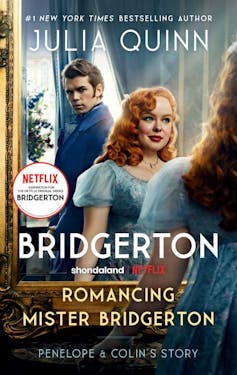Bridgerton watchers started questioning the show’s historical authenticity (again) even before the third season landed. But does historical accuracy actually matter?
Based on the book series by Julia Quinn, Bridgerton is set around the eight Bridgerton siblings, each with their own romance. Romance is the powerhouse of the publishing industry: 19 million romance books were sold in 2022 – over 40% more than the previous year.
We surveyed almost 1,000 readers and writers of historical romance novels from around the world, in 2019 and again in 2023. We asked them what makes a historical romance novel authentic – and does accuracy matter?
Overall, writers were more concerned than readers about historical accuracy. On average, writers’ total scores for requiring accuracy were 4% higher than readers, whose range was wider. Many readers scored accuracy as low as 0 out of 5 as a requirement – but no writer scored accuracy lower than 3 out of 5.
Authors emphasised their own research. Their answers included “It has to be accurate, I research all of my historical knowledge” and “I do a lot of research to make that happen. Research is ongoing.”
‘Icing on the cake’
Readers’ requirements for accuracy were varied. Some said they require authors “to do a lot of research and make the story as authentic and real as possible”, while others said things like “I don’t think there is any responsibility for authors to write historically accurate romances.”

For a small but significant cohort of the readers we surveyed, accuracy was important for ensuring the authenticity of story. Here, readers echoed the writers, calling for “accurate portrayal of life during the era” based on “quality research by author”.
However, for many readers, historical accuracy came second to the romance. “The story comes first,” said one. “The details are just the icing on the cake.” For these readers, “a general broad attention to historical detail is enough”.
Others questioned the need for accuracy. As one reader stated, “if all these novels were historically accurate then these women would be dying of easily preventable diseases having never had orgasms.” The medical realities of the Regency period did in fact mean many women died in childbirth. Not exactly the happily-ever-after ending to which romance novels aspire.
For some readers, historical romances were “a sub-genre of fantasy”, where “the world the characters live in can be historically accurate and sexist AF, but I do not want my hero to be”.
These fantasy historical romances are often dismissed as “wallpaper” historicals: little more than “costume dramas” where “the characters dress up in clothes that more-or-less resemble clothing of the period” and the relationships reflect our contemporary society more than the era in which they are set.
Rejecting whitewashing, celebrating diversity
When considering accuracy, romance readers rejected some elements of history. One reader summed it up: “I am fine (and prefer) if they don’t display open racism/sexism/homophobia […] that would have been commonplace back then.”
Similarly, another reader called for authors “not to perpetuate harmful and untrue narratives of history”, particularly elements of whitewashing for which the historical romance genre and indeed the wider romance publishing industry have been criticised.

Diversity has recently grown within the genre. Favourite authors cited by readers interested in diverse storylines include Beverley Jenkins, who writes African American historical romance, Cat Sebastian and K.J. Charles, who writes queer historical romance, and Courtney Milan, who won a diversity award from the Romance Writers of America and is renowned for calling out racism. These stories offer different windows on the past.
However, readers were not uninterested in history. In fact, both surveys showed they were quite engaged with it – and sought knowledge about the past from a variety of fictional and nonfictional sources.
When reading historical romance, though, one respondent felt: “it’s a fictional work so I don’t hold it to the same standards as a textbook”.
Imagining a better past
Historical romance, however, allows readers to imagine a better past: one in which all members of society can be respected and loved. “I think it’s more important to show that as many people as possible deserve this type of happiness and dignity,” said one reader.

Historical romance novels, like the Bridgerton series, provide a fantasy about the past that reimagines some elements (such as a more tolerant society) while ignoring others (the class structure and slavery that allowed wealth to flourish among the aristocracy). It provides an answer to the problem of women’s subjugation (true love with a progressive man) and reflects 21st-century ideals of equality and inclusivity.
This is more authentic to ideals likely to be held by the romance reader of today, even if historical depictions are less than completely accurate.
As Bridgerton’s Lady Danbury says:
I understand that you believe such subjects as love and devotion, affection and attachment, you find it all trite and frivolous. But have you any idea those very things are precisely what have allowed a new day to begin to dawn in this society?

